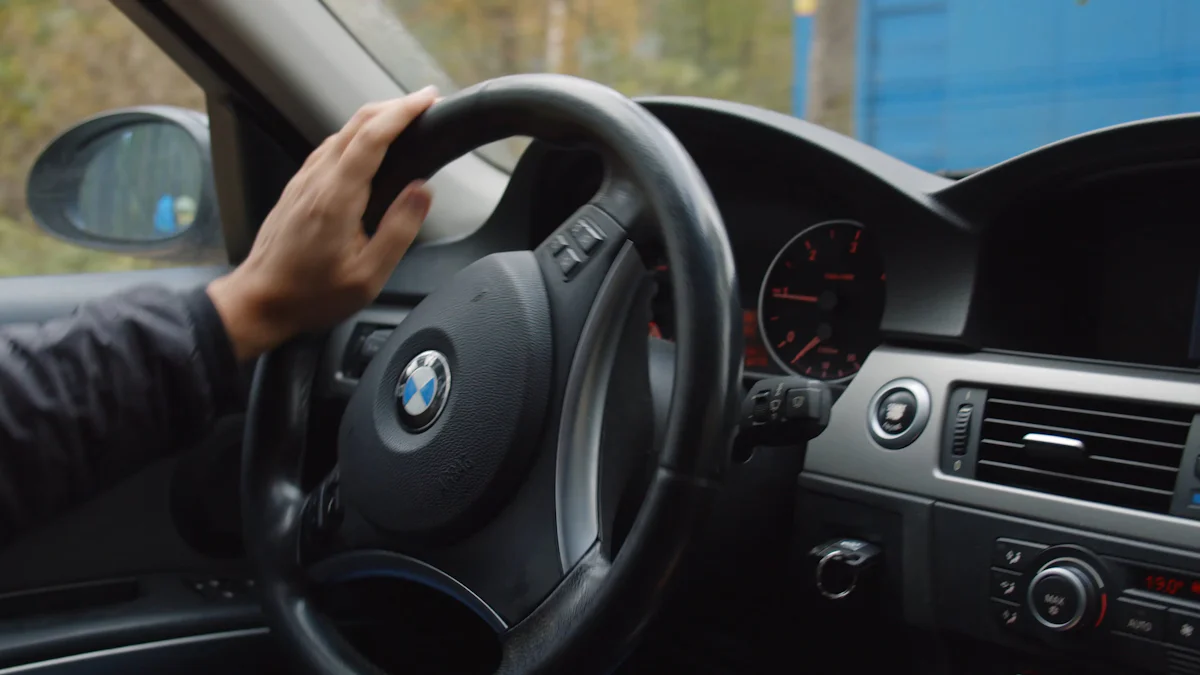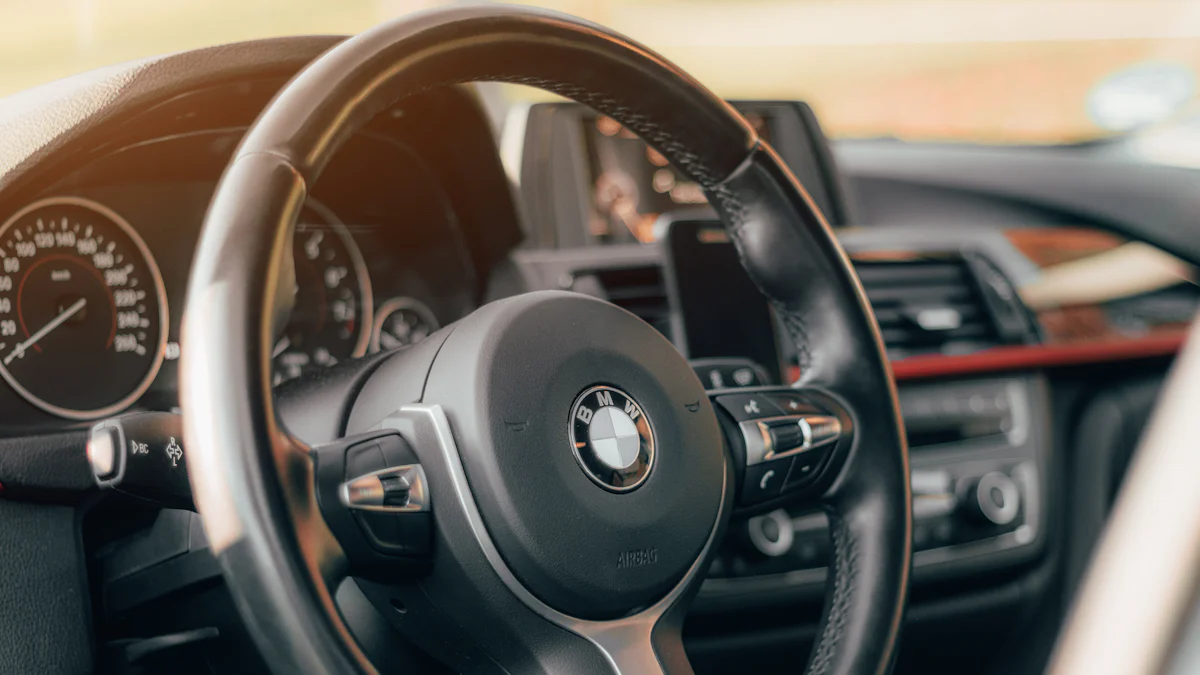How to Choose the Ideal Steering Wheel for Your BMW Model

Choosing the right BMW steering wheel is essential for enhancing your driving experience. The steering wheel serves as your primary connection to the car, influencing comfort, control, and safety. A well-suited steering wheel improves handling by offering a better grip, especially during long drives or intense manoeuvres. It also complements your car’s interior, adding a touch of style and personalisation. Factors like compatibility with your BMW model, material quality, size, and functionality play a crucial role in ensuring the perfect fit. By selecting wisely, you can elevate both the aesthetics and performance of your vehicle.
Key Takeaways
Identify your BMW model and production year using the VIN to ensure compatibility with the steering wheel you choose.
Consider the material of the steering wheel; leather offers durability and luxury, while Alcantara provides superior grip for sporty driving.
Evaluate the size of the steering wheel based on your driving style; standard sizes are versatile, while smaller diameters enhance responsiveness.
Ensure the steering wheel supports essential functionalities like airbags and electronic controls for a seamless driving experience.
Choose between OEM and aftermarket options based on your budget and preferences; OEM offers reliability, while aftermarket provides customisation.
Follow proper installation procedures, including disconnecting the battery and checking all electronic functions post-installation for safety.
Customise your steering wheel to reflect your personal style, ensuring it complements your BMW’s interior aesthetics.
Understanding Your BMW Model
Understanding your BMW model is the first step in selecting the ideal steering wheel. Each BMW model has unique specifications that influence compatibility and performance. By identifying your car’s model and production year, and understanding its steering wheel specifications, you can make an informed decision.
Identifying Your BMW Model and Year
How to locate your car’s model and production year
To find your BMW’s model and production year, check the vehicle identification number (VIN). This 17-character code is usually located on the driver’s side dashboard or inside the door frame. You can also refer to your car’s registration documents or owner’s manual for this information. Knowing the exact model and year ensures that the steering wheel you choose will fit perfectly.
Why compatibility depends on your car’s generation (e.g., E-series, F-series, G-series)
BMW models are categorised into generations, such as the E-series, F-series, and G-series. These generations determine the design and technical specifications of your car. For example, the BMW 1 Series (E81/E82/E88) and 3 Series (E90/E91/E92/E93) belong to the E-series, while the BMW G80 and G82 M3/M4 are part of the G-series. Steering wheels designed for one generation may not be compatible with another due to differences in mounting points, bolt patterns, and electronic systems. Always confirm your car’s generation before purchasing a steering wheel.
Checking BMW Steering Wheel Specifications
Understanding bolt patterns and mounting points
The bolt pattern and mounting points of your BMW steering wheel are critical for proper installation. These features ensure that the steering wheel attaches securely to the steering column. For instance, the BMW M-Style Custom Carbon Fibre Steering Wheel, which fits all 2010+ models with selected upgrade packages, is designed with specific bolt patterns to match compatible vehicles. Choosing a steering wheel with the correct specifications prevents installation issues and ensures safety.
How to determine airbag and electronic control compatibility
Modern BMW steering wheels often include airbags and electronic controls for features like audio and cruise control. When selecting a new steering wheel, verify that it supports these functionalities. For example, if your car has a heated steering wheel or advanced driving assistance systems, ensure the new wheel integrates seamlessly with these features. Consulting a professional or using a fitting chart can help you identify compatible options. Products like the BMW F8X M3/M4 Steering Wheel are designed to maintain compatibility with factory-installed systems, ensuring a hassle-free upgrade.
By thoroughly understanding your BMW model and its steering wheel specifications, you can confidently choose a steering wheel that enhances both functionality and style.
Key Factors to Consider When Choosing a BMW Steering Wheel

When selecting the perfect BMW steering wheel, you must evaluate several factors to ensure it meets your needs. Material, size, and functionality play a significant role in determining comfort, performance, and overall driving satisfaction.
Material
Leather vs. Alcantara: Pros and cons for comfort and durability
The material of your BMW steering wheel greatly influences its feel and longevity. Leather is a classic choice, offering a smooth texture and excellent durability. It resists wear and tear, making it ideal for daily use. Leather also provides a premium look that complements most BMW interiors.
On the other hand, Alcantara is a synthetic material known for its soft, suede-like texture. It delivers superior grip, especially during spirited driving. However, Alcantara requires more maintenance as it can wear out faster if not cared for properly. If you prioritise luxury and durability, leather might be your best option. For enhanced grip and a sporty feel, Alcantara could be the better choice.
How material affects grip and driving performance
The material of your steering wheel directly impacts your grip and driving performance. A leather steering wheel offers a firm yet comfortable hold, reducing hand fatigue during long drives. Alcantara, with its textured surface, ensures your hands stay steady even in high-performance situations. Both materials enhance control, but your choice depends on your driving style and preferences.
Size
Standard vs. smaller-diameter steering wheels: Which is better for your needs?
The size of your BMW steering wheel affects both handling and comfort. Standard-sized steering wheels are versatile and suitable for most drivers. They provide a balanced feel, making them ideal for everyday driving. Smaller-diameter steering wheels, often found in M-Sport models, offer a sportier experience. They allow quicker steering inputs, which can improve responsiveness during dynamic driving.
Your choice should align with your driving habits. If you enjoy a relaxed, comfortable drive, a standard size may suit you. For those who prefer a more engaging and precise driving experience, a smaller-diameter steering wheel could be the better fit.
How size impacts handling and interior aesthetics
The size of your steering wheel not only affects handling but also influences the look of your car’s interior. A smaller steering wheel can make the cabin feel sportier and more compact. It enhances manoeuvrability, especially in tight corners. Conversely, a standard-sized wheel maintains a classic appearance and provides a more traditional driving feel. Consider how the size complements your car’s interior design and your driving needs.
Functionality
Steering wheel controls: Audio, cruise control, and other features
Modern BMW steering wheels often come equipped with integrated controls for added convenience. These controls allow you to adjust audio settings, activate cruise control, and manage other features without taking your hands off the wheel. When choosing a new steering wheel, ensure it supports these functionalities. This not only enhances safety but also improves your overall driving experience.
Heated steering wheels and other advanced options
Advanced features like heated steering wheels can elevate your comfort, especially during colder months. A heated steering wheel keeps your hands warm, making winter drives more enjoyable. Some BMW steering wheels also include paddle shifters for manual gear changes, adding a sporty touch. Evaluate which features align with your preferences and ensure compatibility with your car’s existing systems.
By carefully considering material, size, and functionality, you can select a BMW steering wheel that enhances both your driving experience and your car’s interior aesthetics. Each factor plays a crucial role in ensuring the steering wheel meets your specific needs.
Aesthetics
Matching the steering wheel design to your car’s interior
The design of your BMW steering wheel plays a significant role in maintaining harmony with your car’s interior. A well-matched steering wheel enhances the overall aesthetic appeal and creates a cohesive look. When selecting a steering wheel, consider the materials and finishes already present in your car. For instance, if your interior features leather upholstery, a leather steering wheel can complement it beautifully. Similarly, Alcantara steering wheels pair well with sporty interiors, adding a dynamic touch.
BMW offers a variety of steering wheel designs tailored to different models and trim levels. For example, the M-Sport steering wheels often feature a sporty design with contrasting stitching, which aligns perfectly with performance-oriented interiors. On the other hand, wood-trimmed steering wheels suit luxury-focused models, providing a classic and elegant appearance. By choosing a design that reflects your car’s personality, you can elevate its visual appeal while maintaining a sense of balance.
Customisation options for a personalised look
Customisation allows you to add a personal touch to your BMW steering wheel, making it uniquely yours. Many options are available to help you achieve a personalised look that aligns with your preferences. You can choose from a range of materials, such as carbon fibre for a modern and high-tech feel or Alcantara for a sporty and luxurious vibe. Stitching colours, embossed logos, and unique patterns further enhance the customisation possibilities.
Some drivers opt for steering wheels with coloured accents or perforated grips to create a distinctive appearance. Others prefer adding paddle shifters or custom trims to enhance both aesthetics and functionality. Aftermarket options also provide flexibility, offering designs that may not be available in standard BMW configurations. However, ensure that any customisation maintains compatibility with your car’s systems and adheres to safety standards.
Customising your steering wheel not only improves its visual appeal but also allows you to express your personality. Whether you prefer a sleek and minimalist design or a bold and sporty look, the right customisation can transform your driving experience into something truly special.
Aftermarket vs. OEM BMW Steering Wheels

When choosing a new BMW steering wheel, you will encounter two primary options: OEM (Original Equipment Manufacturer) and aftermarket steering wheels. Each choice offers unique benefits and drawbacks, making it essential to understand their differences before making a decision.
What Are OEM Steering Wheels?
OEM steering wheels are designed and manufactured by BMW or its authorised suppliers. These wheels are built to meet the exact specifications of your car model, ensuring a seamless fit and reliable performance.
Benefits of choosing original BMW parts
OEM steering wheels provide several advantages:
Perfect compatibility: They are tailored to your specific BMW model, ensuring proper fitment and functionality. Features like airbags, electronic controls, and heating systems integrate effortlessly.
High-quality materials: BMW uses premium materials such as leather, Alcantara, and carbon fibre, ensuring durability and a luxurious feel.
Warranty coverage: OEM parts often come with a manufacturer’s warranty, offering peace of mind and protection against defects.
Consistent aesthetics: These steering wheels match your car’s interior design, maintaining a cohesive and polished look.
“OEM steering wheels are ideal for those who value reliability, quality, and a factory-standard appearance.”
Limitations of OEM options
Despite their benefits, OEM steering wheels have some limitations:
Higher cost: Original parts tend to be more expensive than aftermarket alternatives.
Limited customisation: BMW offers fewer design options, which may not satisfy drivers seeking a personalised look or unique features.
What Are Aftermarket Steering Wheels?
Aftermarket steering wheels are produced by third-party manufacturers. These wheels cater to a wide range of preferences, offering diverse designs, materials, and functionalities.
Advantages of aftermarket options (e.g., customisation, cost)
Aftermarket steering wheels provide several appealing benefits:
Customisation: You can choose from a variety of designs, materials, and finishes. Options like carbon fibre steering wheels or coloured stitching allow you to personalise your car’s interior.
Cost-effectiveness: Many aftermarket wheels are more affordable than OEM options, making them an attractive choice for budget-conscious drivers.
Enhanced features: Some aftermarket wheels include advanced features like paddle shifters or ergonomic grips, improving both aesthetics and performance.
“Custom steering wheels, such as the BMW G Series Custom Carbon Fibre Steering Wheel, combine style and functionality, offering a sporty and modern driving experience.”
Potential drawbacks, including quality and compatibility concerns
While aftermarket steering wheels offer flexibility, they also come with potential risks:
Quality variability: Not all aftermarket manufacturers maintain high standards. Poor-quality materials or construction can lead to premature wear or safety issues.
Compatibility challenges: Some aftermarket wheels may not integrate seamlessly with your car’s systems, such as airbags or electronic controls.
Safety concerns: Improper installation or substandard materials can compromise safety, especially during accidents.
How to Decide Between OEM and Aftermarket
Choosing between OEM and aftermarket steering wheels depends on your priorities, preferences, and budget. Consider the following factors to make an informed decision.
Factors to consider: Budget, preferences, and intended use
Budget: If cost is a concern, aftermarket options may provide better value. However, ensure you prioritise quality and safety.
Preferences: For a factory-standard look and guaranteed compatibility, OEM steering wheels are the best choice. If you desire a unique design or enhanced features, explore aftermarket options.
Intended use: For daily driving, OEM wheels offer reliability and comfort. For performance-focused driving, aftermarket wheels with sporty designs and improved grip may be more suitable.
Tips for ensuring quality and safety with aftermarket options
To minimise risks when selecting an aftermarket steering wheel:
Research reputable brands: Choose manufacturers known for producing high-quality products.
Verify compatibility: Ensure the steering wheel supports your car’s features, such as airbags and electronic controls.
Consult professionals: Seek advice from experts or mechanics to confirm fitment and proper installation.
Check safety standards: Look for certifications or reviews that guarantee the product meets safety requirements.
By weighing the pros and cons of OEM and aftermarket steering wheels, you can select the option that best suits your needs. Whether you prioritise reliability, customisation, or cost, the right choice will enhance your driving experience and complement your BMW’s interior.
Installation Tips and Safety Considerations for BMW Steering Wheels
Upgrading or replacing your BMW steering wheel can significantly enhance your driving experience. However, proper installation is crucial to ensure safety and functionality. Follow these steps and tips to install your new steering wheel with confidence.
Preparing for Installation
Tools and equipment you’ll need
Before starting, gather all the necessary tools and equipment. You will need:
A socket wrench set for removing bolts.
A Torx screwdriver for loosening screws.
A steering wheel puller to detach the old wheel.
Electrical tape for securing wires.
A soft cloth to protect surfaces during the process.
Having these tools ready ensures a smooth and efficient installation process.
Disconnecting the battery to avoid airbag deployment
Safety should always come first. Disconnect the car battery before beginning the installation. This step prevents accidental airbag deployment, which could cause injury or damage. Locate the battery in your BMW, usually found in the boot or under the bonnet, and disconnect the negative terminal. Wait at least 15 minutes after disconnecting to allow the system to discharge completely. This precaution ensures a safe working environment.
Installation Process
Step-by-step guide to removing the old steering wheel
Remove the airbag module: Locate the screws or clips holding the airbag in place. Use the Torx screwdriver to carefully detach it. Disconnect the airbag wiring harness and set the module aside in a safe location.
Mark the alignment: Use a marker or tape to note the position of the current steering wheel. This ensures the new wheel aligns correctly.
Loosen the central bolt: Use the socket wrench to remove the central bolt securing the steering wheel. Do not fully remove it yet.
Detach the steering wheel: Attach the steering wheel puller to the wheel and gently pull it away from the column. Once loose, remove the central bolt completely and take off the old wheel.
Properly aligning and securing the new steering wheel
Align the new steering wheel: Position the new wheel on the steering column, ensuring it matches the alignment marks you made earlier.
Secure the central bolt: Insert and tighten the central bolt using the socket wrench. Ensure it is firmly secured to prevent any movement.
Reconnect the airbag module: Attach the airbag wiring harness to the new steering wheel. Carefully position the airbag module and secure it with screws or clips.
Check the connections: Inspect all electronic connections to ensure they are properly attached and functioning.
Post-Installation Safety Checks
Ensuring all electronic controls and airbags function correctly
After installation, test all electronic controls on the steering wheel. Check buttons for audio, cruise control, and other features to confirm they work as intended. Verify that the airbag system is operational by observing the dashboard warning lights. If the airbag light remains on, consult a professional to address the issue.
Test-driving your car to confirm proper installation
Take your car for a short test drive to evaluate the new steering wheel. Pay attention to its alignment, responsiveness, and comfort. Ensure the wheel feels secure and that all features function seamlessly. If you notice any issues, recheck the installation or seek professional assistance.
Expert Tip: “The build quality of your BMW steering wheel plays a vital role in its durability and performance. Ensure proper installation to maximise its lifespan and functionality.” – Age Styling, Automotive Steering Wheel Specialist.
By following these steps, you can safely install your new BMW steering wheel and enjoy an improved driving experience. Proper preparation, careful installation, and thorough safety checks guarantee a seamless upgrade.
Choosing the right BMW steering wheel is a vital step in enhancing your driving experience. By focusing on key factors like compatibility, material, size, functionality, and aesthetics, you ensure that the steering wheel meets your needs. Carefully weigh the benefits of OEM options, such as seamless integration and reliability, against the customisation and cost advantages of aftermarket alternatives. Proper installation and safety checks are essential to guarantee functionality and avoid potential issues. Make an informed decision that not only improves your car’s performance but also adds a personal touch to your BMW ownership journey.
